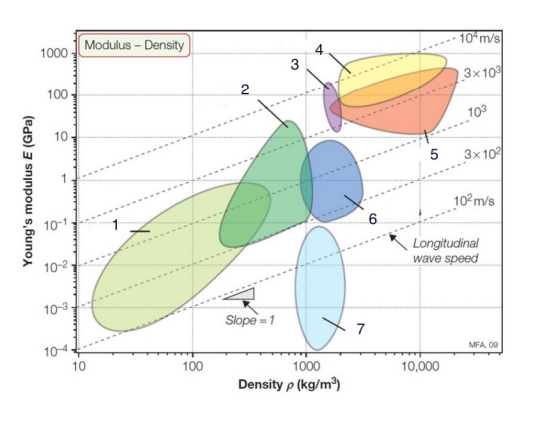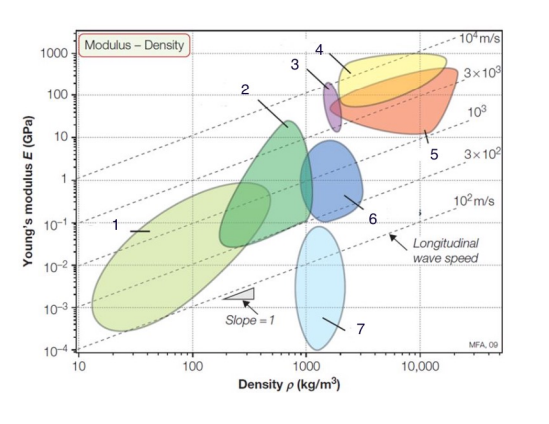MATERIAL (mechanical Engineering Yr1) Term1
1/70
Earn XP
Description and Tags
MATERIALS and their uses... (from manufacturing and materials module)
Name | Mastery | Learn | Test | Matching | Spaced |
|---|
No study sessions yet.
71 Terms
what do we test to see… Design/ Material selection criteria (Fitness for purpose)
The things we test to see :
Ability to withstand loads (strength, yield/ tensile)
dimensional stability (modulus, hardness, creep).. Expansion (Thermal/ moisture)
Durability (maintenance (corrosion, wear, firing)
What are the 3 product construction techniques?
manufacture
joining/ assembly
finishing
What are the 4 environmental factors/ sustainability factors?
availability of resource
energy content
utilization & storage wastes
recycling
what are the 3 aesthetic, primary and finishing process?
appearance
texture
feel
Tests for stiffness and strength
simple- uniaxial loading
complex- bi, triaxial loading
time dependence
environment
scale
testing as part of product/ structure
what are the different types of families of materials?
metals
polymers
ceramics
glasses
elastomers
material property definition: STRONG
definition: ability to carry load or force
material property definition: STIFF
definition: ability to resist deflection
material property definition: TOUGH
definition: ability to resist fracture
material property definition: LIGHT WEIGHT
definition: ability to perform without adding too much extra load
Mechanical properties: (Glossary)
elastic deformation
plastic deformation
elastic modulus
proof stress
tensile strength
plastic strain at fracture (ductility)
hardness
toughness
work hardening
how to calculate stress
force/area [N/m²]
how to calculate strain
change in length/ original length (dimensionless)
how to calculate shear stress
shear force/ shear area [N/m²]
how to calculate shear strain
deflection/ original length [dimensionless]
Elastic Modulus (Young’s Modulus) [N/m² or Pa] how to calculate?
yield strength(stress)/ strain
types of tensile failure (in metals)
ductile fracture
Brittle fracture
Tests for brittle material
tensile: -low variable fracture stress, - elastic deformation followed by fracture… NO plastic deformation.
compression
how to calculate Hardness, H
(F) Load/ Area (A)
how to calculate Vickers Hv Scale
H/ 10 [kg/mm²]
what is creep?
time dependent strain at constant stress
what is fatigue?
failure of material when it is subject to cyclic or fluctuating stress.
what is product tolerance?
allowable size range specified in the design and specified in Eng drawings
what is a + and - tolerance called?
Bilateral tolerance
what is process tolerance?
size range (limits) likely to occur due to the method of manufacture
what are the 3 reasons for process tolerance?
nature of manufacturing
variability in material
wear on tools and machines
types of basic process for metals (5)
casting
deformation
powder metallurgy
welding
material removal
what is metrology?
term for science of measurement of dimensions and shapes
why is meteorology important for manufacturing?
important for control of manufacturing processes and inspection of products.
9 factors that help identify materials
material color/ surface condition or appearance
density (mass per unit volume)
magnetic?
hardenability
tensile test
spark test
melting point
action of acids
action of alkalis
how can we identify material using density
weighing a material sample (archimedes principle for measuring density)
what is Archimedes principle for measuring density?
immersed sample in water measure mass (mass of sample in water - mass of water) giving M2 (force of buoyancy)= volume of water displaced
mass not immersed in water (kg) M1
M1/ M2= density in [Kg/10³g]
need to then convert to [kg/m³]
what is the spark test?
piece of metal held against a grindstone (different metals will produce difference forms and colors of …)
how will acids react with steel?
all acids attack steels, whenever moisture combined with oxygen, rusting place. (common salts will accelerate corrosion when combined with water.

Name the materials on the Ashby diagram (numbered from 1 to 7)
foams
natural materials
composites (materials made from multiple materials or mixed with another material to make it stronger)
ceramics
metals
polymers
elastomers

what is a Ferrous metal?
a metal that contains Iron [Fe]
what are cast iron’s properties (Ferrous metal)
properties:
poor ductility
poor tensile strength
poor plasticity
poor toughness
poor malleability (due to flakes of graphite)
typically the alloy contains 2.5% to 4% carbon)
typically the alloy contains 1% to 3% silicon
typically the alloy contains 0.1% to 1.2% Manganese
good compressive strength
how can properties of Cast Iron be improved
treating it to alter structure of carbon in it.
what properties does iron (ferrite) impart in carbon steel:
ductility
malleability
plasticity
magnetism
softness
some elasticity
Low carbon steel [MILD STEEL] properties (ferrous metal)
contains 0.5% to 0.25% carbon by weight (mass of carbon emission)
contains 0.6% to 0.9% of Manganese
doesn’t increase in hardness as physical force is applied (doesn’t work harden)
BUT cold bending and hammering causes work hardening
*NOTE: hardening can be removed by heat treatment
good welding properties
what properties does medium/ high carbon steel have
contains about 1% carbon
contains up to 1.65% Manganese
some specific quantities for deoxidization
higher % of carbon= higher tensile strength and hardness
higher % of carbon= reduced ductility and malleability
higher % of carbon= greater risk of welds and bends cracking
readily forming rust (rusting when exposed to oxygen and water)
heavy scaling when at red heat (forging)
what are alloy steels used for mainly? (ferrous metal)
used to obtain enhanced properties specifically higher strength, hardness, wear and corrosion resistance.
what do alloy steels tend to be mixed with? (ferrous metals)
Nickle [Ni], Chromium [Cr] and Molybdenum [Mo]
Chromium [Cr] and Vanadium [V]
could have high carbon [1%] (used for production of ball bearings)
Manganese [Mn]
Copper [Cu]
Tungsten [W]
Titanium [Ti]
what are non-ferrous metals?
metals that do not contain iron
copper (non ferrous metal) metal, what is it’s properties?
soft in annealed conditions (annealing= heat treatment process which changes physical and sometimes chemical properties)
red color (recognizable)
harder by cold working (e.g hammering, rolling or pressing)
what are three advantages of copper?
excellent for deep drawing extrusion and drawing into wire
can be annealed by heating to dull red (500 degrees Celsius) and allowing to cool or quenched (quenching is rapid cooling to adjust mechanical properties)
resistant to corrosion BUT attacked by Nitric and Hydrochloric acid quite vigorously
2 examples of non- ferrous metal copper alloys and their percentages
Brass, (copper-zinc Alloy) 67% Cu and 33% Zn
Phosphor Bronze (Copper-Tin Alloy) 0.5-11% Sn and 0.01-0.35% P
properties of copper alloy (non ferrous metal) BRASS (Zn and Cu):
higher malleability than zinc and copper
low melting point (900 degrees C)
flows when melted
when combined with iron, Al, Si, Mn make corrosion resistance
capable of stress cracking when exposed to Ammonia (NH3)
not as hard as steel
what other elements can be added to phosphor bronze to create what specific properties?
(0.5-3% of Lead) forming free-machining phosphor bronze:
used for springs, bolts, bushings and bearing.
density of Aluminum
2700 kg/m³
what does UTS stand for and what does it mean
Ultimate Tensile Strength- material’s maximum stress tolerance before breaking under tension, determining how a material behaves under load
properties of Aluminum/ Aluminum Alloys
silvery-white
lightweight metal
soft and malleable
PURE Al relatively weak
Al ALLOYS have higher UTS than pure Al of about (500 N/mm²)
doesn’t rust BUT does corrode
low melting point of about 660 C
economically cost efficient
how does Aluminum protect itself from corrosion and what is the possible step backs
the aluminum oxide coating highly resistant and renwes itself if damaged keeping it relatively safe from corrosion
BUT
some factors can cause coat to become unstable
what is Anodising
a protective surface treatment to enhance oxide coating (the Aluminum oxide coating which helps avoid corrosion of Al)
what are some applications of Aluminum
extrusion
anodising
pressure die casting
what is a composite material?
material made from 2 or more different types of material
two examples of composite materials that are “fiber”
Carbon fiber re-enforced polymer CFRP
Glass fiber GFRP
(RP= reinforced polymer)
what is Carbon fibre (CFRP) made up of?
90% of carbon fiber: Polyacrylonitrile (PAN)
10% of carbon fiber: rayon or petroleum pitch
what is carbon fiber?
organic polymers (PAN, Rayon and petroleum pitch) characterized by long strings of molecules bound together by carbon atoms
what is Glass fiber made up of (GFRP)
non-crystalline material with short range network structure
name 4 advantages of composites
freedom to tailor the thickness, shape (to increase strength of functionality) etc.
reduce weight
reduction of no. of parts in design
doesn’t corrode like steel or Al
what material is used in industrial ceramics (engineering ceramics)
Alumina [aluminum oxide Al2O3]- inert, odorless, white amorphous material used in industrial ceramics
what are the uses of Alumina (eng ceramic)?
life extending application
society enhancing application
used in medical field
why is Alumina used in the medical field (what properties does it have that makes it helpful)
hardness
bio-inertness
chemical properties
what are some examples of when Alumina (eng ceramic) used in the medical field?
bionic implants
prosthetic eyes
tissue reinforcements
dental crowns
abutments
bridges
(dental implants)
lab equipment
what is Tungsten Carbide (WC) and some examples of tools that use WC
compound of tungsten [W] and carbon [C]. known for superior durability and high melting point (2,870 C)
widely used in applications that require superior wear or impact resistance (abrasives, cutters, dies and bunches)
meaning of Biomedical materials (Biomaterials)
biomaterial is metal, ceramic, polymer OR natural materials that can be used to provide structure or function to an implantable medical device in the body
materials for biomaterials and their characteristic they’re known for
wear resistant metal alloys
bioactive ceramics
biodegradable polymers
application and examples of biomaterials (METAL)
stainless steel: [Nickle, chrome alloy with iron and low carbon content] LOW infection results when nickel free alloys are used.
Titanium alloys: provides good results with low rates of infection
APPLICATION: orthopedic surgery, dental surgery, bone screws, hip/knee replacements
applications and examples of biomaterials (CERAMICS)
Aluminum oxide (alumina) AND zirconium oxide (ZrO2)
APPLICATION: deposited on metal surfaces cuz extremely hard and offer good wear resistance. artificial bones. Dentistry (implants)
good corrosion resistance… ALMOST chemically inert
BUT BRITTLE
applications and examples of biomaterials (POLYMERS) [what types of polymers ae used]
Polyurethanes/ polyester
polycarbonate/ polyethylene
APPLICATION: prostheses, tissue engineering, drug delivery tubes, special mesh for wound management [NOT all biodegradable], plastic liners hip replacements